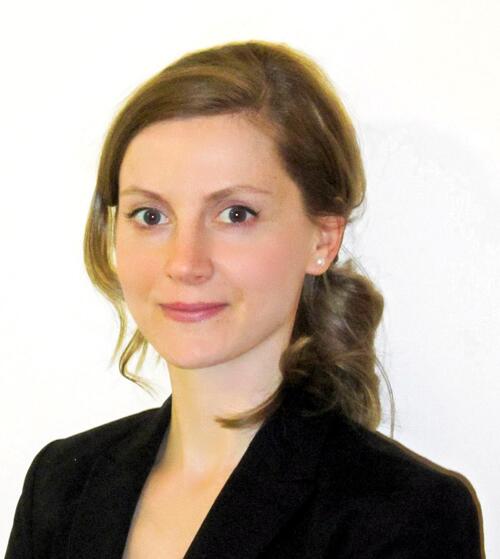
Training the manufacturing workforce of tomorrow
Waterloo lab helps fill industry demand for additive manufacturing skills

Waterloo lab helps fill industry demand for additive manufacturing skills
By University Relations
Mihaela Vlasea
Professor, Faculty of Engineering
> Associate Research Director, Multi-Scale Additive Manufacturing Lab
Grace Kurosad reaches into a large 3D metal printing machine that uses automated mechanisms and lasers to build metal parts, layer by layer, from a powder substrate.
It’s a high-tech skill. Wearing full personal protective equipment to keep her from breathing any of the metal powder, Kurosad has become something of machine whisperer. She keeps the sophisticated parts humming along in the Multi-Scale Additive Manufacturing (MSAM) lab at the University of Waterloo, where she now works full time.
The MSAM lab is Canada’s largest academic-based research and development facility in metal additive manufacturing. It has every class of state-of-the-art 3D metal printing machinery, including custom 3D printers that work with composites such as graphene, polymers and ceramics.
Kurosad has found a whole new career in additive manufacturing through the lab.
She previously worked as a technician at smartphone maker BlackBerry and subsequently at wearable device maker Thalmic Labs in Waterloo. But she wanted a career with long-term potential and she saw it in additive manufacturing.
“You can see how it has a lot of potential for the future,” Kurosad says. “It’s exciting to see, for example, a part for a human body being built. That’s why I joined this team. I will never get bored.”
With the decline of traditional factories in recent decades, few young people think about careers in making parts. Instead, they see the future in software or maybe robotics. Now, with faster and better 3D printing that can custom-make durable parts in one piece without the expense of the tooling, a whole new chapter in manufacturing has begun.
“Additive manufacturing is reshaping the way manufacturing looks,” says Mihaela Vlasea, a professor in mechanical and mechatronics engineering and associate director at the MSAM lab at Waterloo.
Vlasea is part of the MSAM team that includes research director Ehsan Toyserkani and managing director Vladimir Paserin. The lab now has a complement of more than 60 people including faculty, postdoctoral fellows and research associates, technicians, graduate and undergraduate students. In addition, more than 15 affiliated faculty and their students across campus engage in research activities.
One of Vlasea’s PhD students, Gitanjali Shanbhag, is researching biomedical applications to advance health care. “The role of additive is becoming increasingly important in health care through its utilization in implant design, surgical planning, therapeutic delivery and tissue engineering,” Shanbhag explains. In addition to doing research and development with industry partners, the lab is developing the talent pool to fill the gap in those industries.
Many companies in the aerospace sector, for example, are scaling up their additive manufacturing production. New companies are also setting up shop to produce parts and services for their customer base. But finding people with the right skills is not easy.
“There is a huge need for people with these skills,” Vlasea says. “We are finding that we can barely hold on to our students as they finish their degrees. Sometimes they leave for industry and come back to finish their degrees part-time.”
The MSAM lab strives for strong research programs and courses in support of graduate programs in additive manufacturing and runs regular workshops benefiting professionals working in area industries. The lab has collaborations with more than 22 industry partners. Industries often send their engineers to learn about the latest developments and then replicate what the lab is doing on their factory floors.
People tend to think of 3D printing as a simple matter of pushing a button to have a perfect part pop out, but it’s enormously complex. “It takes a lot of effort to be able to define all of the little levers in the process to generate quality parts,” Vlasea says.
Additive manufacturing requires multidisciplinary skills and integrates everything from materials science and product design to robotics and computational data analytics, she says. Even areas such as machine learning and computer vision are part of it.
“It's bringing more excitement back into manufacturing, especially for this young generation of students who live in the digital space,” Vlasea says.

Read more
The world is at a historic crossroads with the largest generation of young people coming into the workforce at the same time as the fourth industrial revolution.

Read more
Waterloo researcher links culturally inclusive teams to an increase in revenue and productivity

Read more
SheCycle keeps girls healthy and in school with a sanitary pad
The University of Waterloo acknowledges that much of our work takes place on the traditional territory of the Neutral, Anishinaabeg, and Haudenosaunee peoples. Our main campus is situated on the Haldimand Tract, the land granted to the Six Nations that includes six miles on each side of the Grand River. Our active work toward reconciliation takes place across our campuses through research, learning, teaching, and community building, and is co-ordinated within the Office of Indigenous Relations.